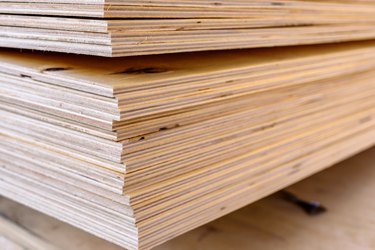
Plywood is arguably among the most important building products of the last century. Technically, the process of gluing together sheets of veneer has been done for hundreds of years if not longer, but mass-produced, engineered plywood revolutionized construction, particularly in war years. Today, engineered wood products mean a DIYer has more from which to choose, like particleboard and MDF, and considering the pros and cons of each is important because the differences are substantial.
The Same But Different
Video of the Day
Search for plywood with a retailer like Home Depot, and it will include particleboard, medium-density fiberboard (MDF), and oriented strandboard (OSB). It's easy to think they're all the same since they're basically "wood plus glue plus pressure." If you saw "meat and potatoes" on a menu, you'd ask how they're prepared, wouldn't you? After all, steak and mashed spuds are a very different meal than a burger and fries, but they're both meat and potatoes. Do a deep dive into various sheet wood products and you'll see all kinds of differences, but sometimes, it comes down to the right look.
Video of the Day
Plywood is strips of veneer cross-laminated; one sheet of veneer's grain runs one way, and the next sheet runs the opposite way. They're glued and then pressed together to create sheets anywhere from 1/8 to over 1 1/2 inches thick. OSB is oriented strandboard, in which strands or flakes of wood are glued together and formed into sheets.
Particleboard is similar but with smaller chips of hardwood and softwood combined with resin to create sheets. MDF is more processed. Waste wood is broken into fibers, combined with resins, and then formed into panels via a high-heat process.
Each has its own appeal, but only one looks like real wood — plywood — and the price reflects this too. When water is a concern, like with subflooring, you'll find plywood is the way to go.
The Upsides of Plywood
The lateral strength of plywood and the engineering processes through which it's made make it incredibly tough, even more so when it's 3/4 inch thick or more. Plywood is also available in many grades and finishes, from sanded and hardwood-facing to pressure-treated, tongue-and-groove, and various construction grades, including marine plywood.
With so many advances in the last century, plywood is arguably stronger than natural wood today thanks to the cross-grain structure that's developed in the veneer-core process. Because wood usually expands and contracts in the direction of the grain, this cross-stacking process prevents that expansion/contraction cycle, which is what makes it so strong.
Plywood is lighter than most other products. It's also able to flex, making it ideal for curved projects. There are several grades, from A to D, with grade A being free of defects, smooth, and meant to be seen. It's great for finishing work and for staining. Grade D, however, is unsanded, and it will have large knots and even filler in places. This is used in structural applications where it will be covered or unseen. You can even have two different grades on the same sheet depending on which side is visible.
The Downsides of Plywood
Compared to the other "glue boards" out there, plywood is a premium product and is priced accordingly. Its real-wood look brings a lot of appeal and a big jump in price. There are a few other areas in which plywood is outshone by the others, particularly when it comes to detailed cutting. MDF is growing more popular all the time for furniture and cabinetry, though some homeowners will snub their nose at it.
The reality is that the edges of plywood are tricky for both cutting and for screwing things into it, and it's known to splinter and crack. MDF, on the other hand, can be a delight to work with even with finer scroll saw and jigsaw work. Plywood takes more effort because it may need sanding, and the edges often require finishing because the veneer layers are exposed.
The list of plywood's downsides is a fairly short one, but it should be noted that it's less environmentally friendly than the other pressed boards because it uses veneer from fresh timber, whereas the others are made from industry byproducts. However, with plywood being more water-resistant, greater at load bearing, perfect for staining, and stronger, it's arguable that its longevity helps offset its environmental footprint.